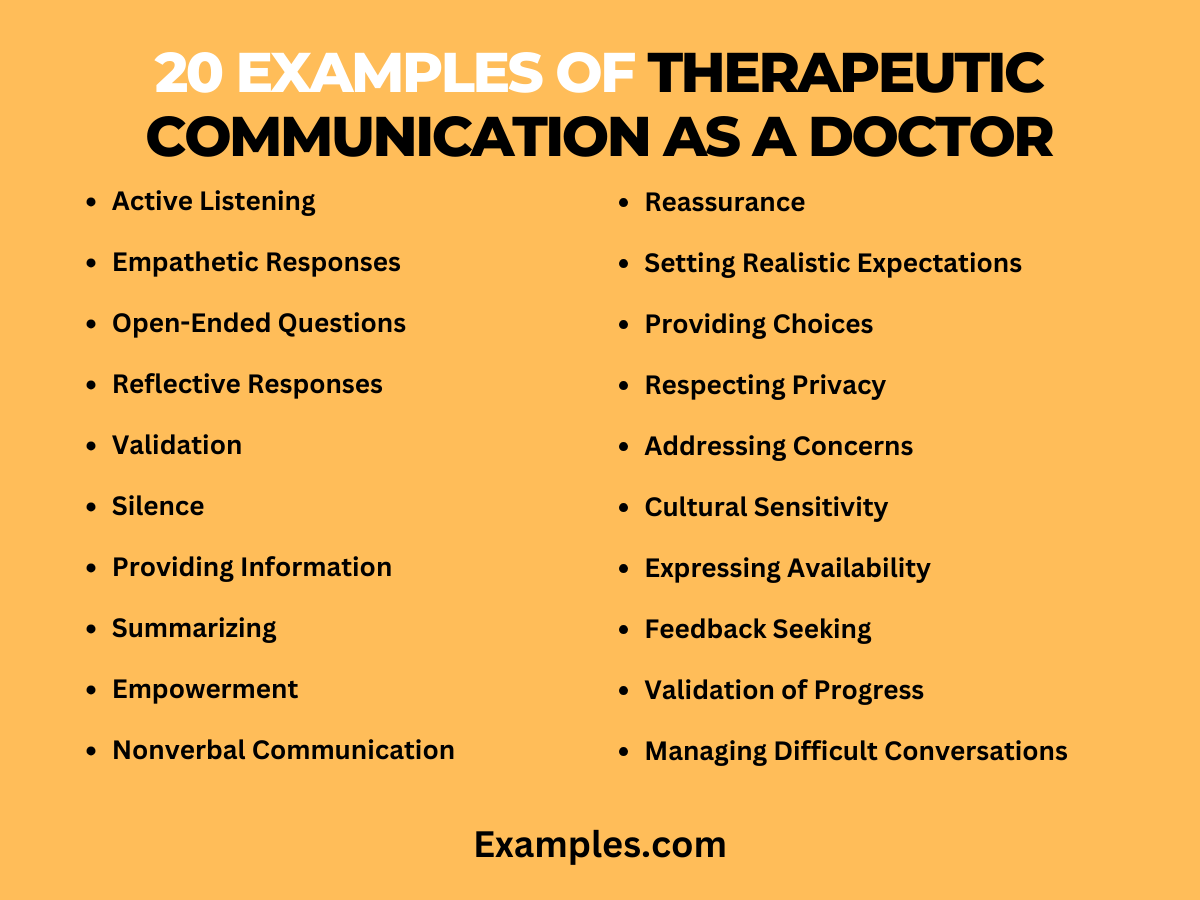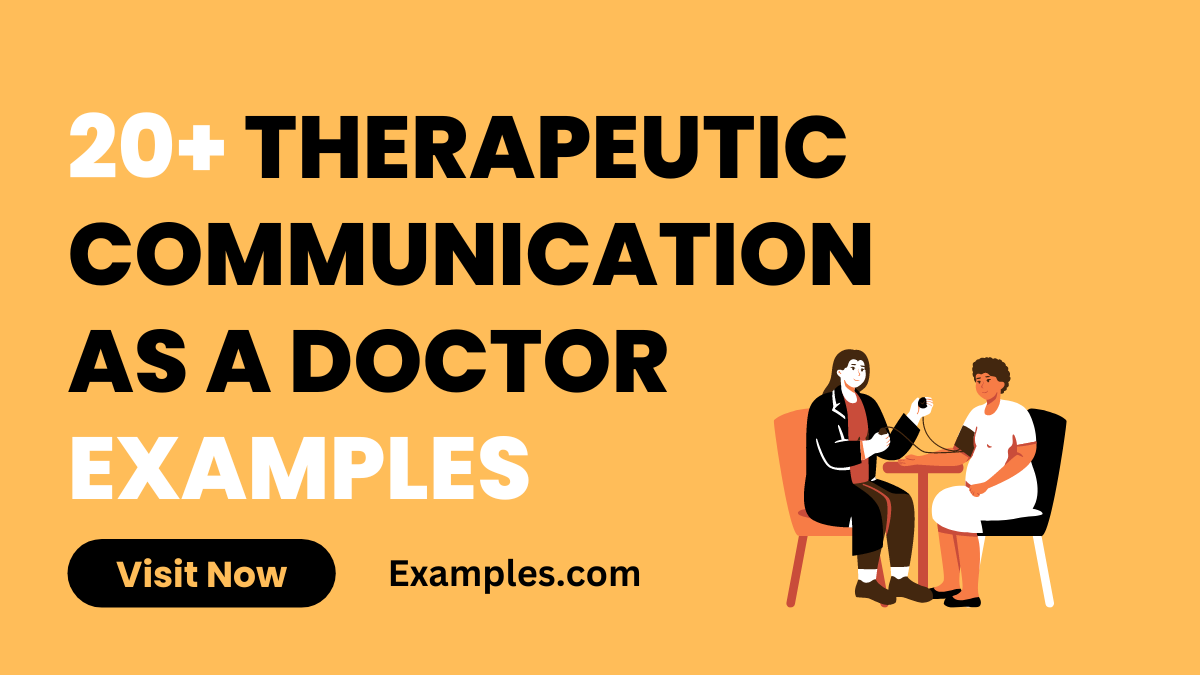Therapeutic Communication as a Doctor
Unlock the transformative potential of therapeutic communication as a doctor in this comprehensive guide. Explore effective techniques and principles to foster meaningful connections with patients. Learn how to navigate sensitive conversations, provide empathetic support, and utilize oral communication examples to enhance patient outcomes. Discover the vital skills needed to navigate the complex landscape of healthcare, strengthen doctor-patient relationships, and deliver compassionate care. This guide equips you with the tools to excel in your medical practice through the art of therapeutic communication.
What is Therapeutic Communication as a Doctor?

Therapeutic communication as a doctor refers to the skillful and empathetic exchange of information between a healthcare provider and a patient. It goes beyond the mere conveyance of medical facts; it involves creating a supportive and trust-based environment where patients feel heard, understood, and valued. Through verbal and non-verbal techniques, doctors aim to alleviate anxiety, build rapport, and collaborate with patients in their care journey. Therapeutic communication is a cornerstone of patient-centered healthcare, fostering mutual respect and enhancing the overall quality of medical interactions.
20 Examples of Therapeutic Communication as a Doctor
In the healthcare domain, therapeutic communication is a vital skill for doctors. Here, we present 20 diverse and effective examples of how doctors can employ therapeutic communication techniques to connect with their patients. These techniques encompass active listening, empathy, clear communication, and addressing emotions. By mastering these examples, doctors can foster trust, enhance patient-doctor relationships, and provide the best possible care to their patients, resulting in improved healthcare experiences and outcomes.

- Active Listening: Display genuine interest and attentiveness while a patient shares their concerns. This helps patients feel valued and understood, fostering trust and open communication.
- Empathetic Responses: Respond to a patient’s emotions with empathy and understanding. For instance, saying, “I understand that this news is difficult for you” acknowledges their feelings.
- Open-Ended Questions: Encourage patients to express themselves by asking questions that require more than a simple “yes” or “no” answer. For example, “Tell me more about your symptoms.”
- Reflective Responses: Reflect back what the patient has shared to show you’re actively listening. For instance, “So, if I understand correctly, you’re feeling anxious about the upcoming surgery?”
- Validation: Acknowledge the patient’s feelings and experiences. For instance, “It’s completely normal to be worried before a procedure like this.”
- Silence: Use silence strategically to give patients space to think and speak. Sometimes, silence can encourage patients to share more.
- Providing Information: Offer clear and concise information about a patient’s condition and treatment options. Make sure it’s easily understandable.
- Summarizing: Summarize the key points of a discussion to ensure mutual understanding. This helps prevent misunderstandings.
- Empowerment: Encourage patients to actively participate in their healthcare decisions. For example, “You have options, and together, we’ll decide on the best approach.”
- Nonverbal Communication: Pay attention to your body language, maintaining eye contact and open posture to convey attentiveness and care.
- Reassurance: Offer reassurance when appropriate, such as, “I’m here to support you throughout your recovery.”
- Setting Realistic Expectations: Ensure patients have realistic expectations about their treatment outcomes to avoid disappointments.
- Providing Choices: When possible, provide patients with choices, empowering them to make decisions regarding their care.
- Respecting Privacy: Always respect a patient’s privacy and confidentiality, creating a safe environment for open communication.
- Addressing Concerns: Encourage patients to voice any concerns or questions they may have. Make it clear that their concerns are valid and will be addressed.
Types of Therapeutic Communication for Doctors
Therapeutic communication encompasses diverse techniques that doctors can employ to facilitate effective patient interactions. These techniques are essential for building trust and promoting patient well-being. Here, we explore various types and provide ten unique examples:
- Active Listening: Doctors listen attentively to patients, using cues like nodding and verbal affirmations to convey understanding.
- Empathy Expression: Expressing empathy, such as saying, “I understand how challenging this must be for you,” validates patients’ emotions.
- Clear Communication: Doctors use simple language and visuals to explain complex medical information, ensuring patient comprehension.
- Open-Ended Questions: Encouraging patients to share more by asking questions like, “Can you describe your symptoms?” fosters open dialogue.
- Silence Utilization: Allowing silent pauses during conversations gives patients space to express themselves without pressure.
- Cultural Sensitivity: Doctors adapt their communication to respect diverse cultural backgrounds, ensuring inclusivity.
- Conflict Resolution: Addressing conflicts with patience and diplomacy preserves a positive doctor-patient relationship.
- Setting Realistic Expectations: Doctors communicate expected outcomes and potential challenges realistically.
- Non-Verbal Communication: Being mindful of body language, gestures, and facial expressions helps convey empathy and respect.
- Follow-Up Communication: Regular follow-up communication shows continued support and commitment to the patient’s well-being.
Doctors Therapeutic Communication Skills for Patients
Doctors require a specific set of therapeutic communication skills to provide compassionate and patient-centered care. These skills encompass active listening, empathy, and clear communication. Here are ten examples with explanations:
- Empathetic Listening: Doctors attentively listen and empathize with patients, saying, “I understand your concerns,” to foster trust.
- Clear Explanations: Using simple language and visuals, doctors explain medical jargon, ensuring patients grasp their condition and treatment.
- Open-Ended Questions: Encouraging patients to share more by asking questions like, “Can you tell me more about your symptoms?” promotes dialogue.
- Reflective Responses: Doctors reflect patients’ emotions and thoughts, saying, “It sounds like you’re feeling anxious,” to validate their feelings.
- Silent Pauses: Allowing moments of silence lets patients gather their thoughts and express themselves without pressure.
- Respectful Tone: Maintaining a respectful and courteous tone throughout the interaction preserves patients’ dignity and strengthens the doctor-patient relationship.
- Cultural Competence: Being culturally sensitive and adapting communication styles to respect patients’ diverse backgrounds ensures inclusivity and effective communication.
- Personal Connection: Establishing a personal connection by expressing genuine care enhances the patient’s overall experience.
- Conflict Resolution: Addressing conflicts with patience and diplomacy helps maintain a positive therapeutic relationship.
- Setting Boundaries: Doctors must maintain professional boundaries while preserving empathy and respect, striking a balance between compassion and objectivity.
What Therapeutic Communication Skills Do Doctors Need?
Effective communication is the cornerstone of healthcare, and doctors play a vital role in establishing trust and rapport with their patients. The art of therapeutic communication goes beyond conveying medical information; it involves creating a supportive and empathetic environment where patients feel valued and heard. Here are the essential therapeutic communication skills that doctors should possess:
1. Active Listening
Active listening is the foundation of therapeutic communication. Doctors must attentively listen to their patients, giving them their full attention. This skill involves not only hearing the words spoken but also understanding the emotions and concerns behind them.
2. Empathy
Empathy is the ability to understand and share the feelings of another person. Doctors should demonstrate empathy by acknowledging their patients’ emotions, showing compassion, and validating their experiences. This helps patients feel understood and cared for.
3. Clear and Effective Communication
Doctors must convey complex medical information in a clear and understandable manner. Avoiding medical jargon and using plain language ensures that patients can make informed decisions about their health.
4. Respect for Autonomy
Respecting patients’ autonomy means involving them in the decision-making process regarding their healthcare. Doctors should provide information, discuss treatment options, and consider patients’ preferences and values.
5. Nonverbal Communication
Nonverbal cues, such as maintaining eye contact, open body language, and appropriate facial expressions, play a significant role in communication. These cues convey empathy and interest in the patient’s well-being.
6. Cultural Competence
Healthcare professionals encounter patients from diverse cultural backgrounds. Doctors should be culturally sensitive, recognizing and respecting different customs, beliefs, and traditions. Tailoring communication to each patient’s cultural context fosters trust.
7. Conflict Resolution
In healthcare, conflicts or disagreements may arise. Doctors need skills in conflict resolution to address such situations professionally and amicably. Resolving conflicts maintains trust and the doctor-patient relationship.
8. Emotional Regulation
Doctors often deal with emotionally charged situations. It’s crucial for them to manage their own emotions effectively, providing a stable and reassuring presence for their patients, especially during difficult moments.
9. Privacy and Confidentiality
Maintaining patient privacy and confidentiality is fundamental. Doctors should ensure that all patient information remains confidential, respecting their trust and fostering open communication.
10. Patient Education
Educating patients about their medical conditions, treatment options, and preventive measures empowers them to actively participate in their healthcare. Doctors should be skilled in providing clear and concise patient education.
What Are Some Therapeutic Communication Techniques for Doctors?
Therapeutic communication is an essential aspect of healthcare that fosters trust, understanding, and empathy between doctors and patients. Doctors employ various techniques to ensure effective and compassionate communication. Here are some key therapeutic communication techniques that doctors should master:5.
1.Summarization
Summarizing involves condensing complex information and repeating it back to the patient. Doctors ensure that patients understand the key points discussed during the appointment. Summarization promotes clarity and reinforces the doctor-patient partnership.
2. Silence
Sometimes, silence can be a powerful therapeutic communication technique. Allowing patients a moment of silence encourages them to collect their thoughts and express themselves without feeling rushed.
3. Avoiding Medical Jargon
Doctors should avoid using medical terminology that patients may not understand. Clear and plain language helps patients comprehend their diagnosis, treatment options, and care plans.
4. Use of Nonverbal Cues
Nonverbal communication, such as maintaining eye contact, nodding, and using appropriate body language, conveys empathy and attentiveness. These cues reinforce the doctor’s commitment to the patient’s well-being.
5. Cultural Sensitivity
Doctors must be culturally sensitive, recognizing and respecting patients’ diverse backgrounds. Tailoring communication to align with a patient’s cultural beliefs and practices enhances trust and understanding.
6. Collaborative Decision-Making
Involving patients in healthcare decisions empowers them and strengthens the doctor-patient relationship. Doctors should discuss treatment options, risks, and benefits, considering patients’ preferences and values.
7. Respecting Patient Privacy
Maintaining patient privacy and confidentiality is crucial. Doctors should ensure that discussions and medical information remain private, respecting patients’ trust.
8. Providing Reassurance
Offering words of reassurance can alleviate patients’ anxiety and concerns. Doctors should communicate hope and support, emphasizing their commitment to the patient’s well-being.
9. Acknowledging Feelings
Doctors should acknowledge patients’ emotions and validate their experiences. Recognizing a patient’s fear, sadness, or frustration demonstrates empathy and fosters trust.
10. Educational Techniques
Doctors employ educational techniques to explain medical conditions, treatment plans, and preventive measures. Visual aids, diagrams, and simple language enhance patient understanding.



